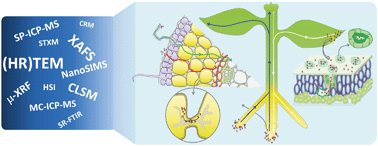Uptake, translocation, and transformation of metal-based nanoparticles in plants: recent advances and methodological challenges†
Abstract
Interactions between engineered nanoparticles (ENPs) and plants represent one of the fundamental problems we must face in the rapid development of nanotechnology. Hundreds of studies have addressed this issue in the past decade. This review summarizes recent research progress on the uptake, translocation and transformation of metal-based ENPs in higher plants. The integrated uptake and transport pathways of ENPs in plants are summarized and the key physiological barriers to plant uptake of ENPs are proposed. Transformation of ENPs in the soil–plant system is discussed, paying particular attention to the effects of phyllosphere and rhizosphere processes on the transformation and plant uptake of ENPs. The advances, limitations and challenges of analytical techniques for the qualitative and quantitative analysis for ENPs in plants are addressed. Furthermore, the key challenges in each field are thoroughly assessed and future perspectives are proposed. This review is intended to provide an unambiguous assessment of the present knowledge on the uptake, translocation and transformation of NPs in higher plants, and also to provide guidance for future research.

- This article is part of the themed collections: Best Papers of 2019 from RSC’s Environmental Science family journals and Best Papers 2019 – Environmental Science: Nano


 Please wait while we load your content...
Please wait while we load your content...